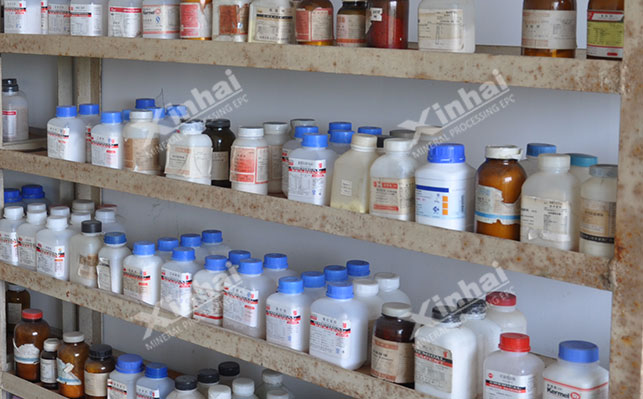
15311826613
Click to add WeChatTin is an indispensable mineral raw material in the development of modern science. It is used in aerospace, superconducting materials, nuclear power generation and other high-tech fields. Although my country's tin ore resources are relatively abundant, they often coexist with a variety of minerals, such as beryl, tantalite and columbite, and associated wolframite, iron oxide ore, etc. If you want to obtain ideal tin concentrate from these tin ores with complex symbiotic relationships, you need to grind them first. At the same time, because cassiterite is brittle, it is very easy to over-crush during the grinding process, producing a large amount of fine mud. Therefore, flotation is often used for beneficiation. The selection of reagents in the process is particularly important. Let's take a look at what reagents are commonly used in the flotation of fine-grained tin ore?

There are many types of collectors used in fine-grained tin ore dressing, and the more common ones include fatty acids, arsenic acid, hydroxamic acid, sulfonated succinic acid and phosphonic acid.
Fatty acid collectors: Mainly used to collect oxides, among which oleic acid and sodium oleate can be used as representatives, followed by cyclohexane acid, 731, tall oil, etc. Oleic acid has strong capture ability, low dosage, and low toxicity. It is currently a commonly used agent in tin ore dressing plants. However, this agent also has certain disadvantages. It is less sensitive to Ca2+ and Fe3+ and has poor capture performance.
Arsenic acid collectors: According to the different types of energy groups, it can be divided into two categories: aromatic arsenic acid and aliphatic arsenic acid. Arsenic acid is a dibasic weak acid that is tightly bound to the surface of cassiterite. The exposed hydrocarbon group can make the mineral hydrophobic to achieve the purpose of capture, and can effectively combine with Sn4+, Sn2+, etc. to form insoluble substances.

Hydroxamic acid collectors: Compared with arsenic acid, this type of agent is less toxic and can replace arsenic acid for cassiterite flotation. The commonly used agent is salicylic hydroxamic acid, which has a good collection effect under alkaline conditions and is often used in combination with TBP. For example, when salicylic hydroxamic acid is used to flot cassiterite, a certain amount of Pb2+ can be added to the slurry to activate it. The disadvantage of this agent is that it has a weak collection ability when used alone, a large amount is used, and the price is high.
Alkyl sulfonated succinic acid collectors:This type of collector has a complex molecular structure (with sulfonic groups and multiple hydroxyl groups). Although it has a strong collecting ability, its selectivity is poor. During operation, it usually relies on electrostatic adsorption and chemical adsorption to adsorb on the ore surface. Among them, A-22 is a common alkyl sulfonated succinic acid collector. Because it has multiple active groups, it reduces the consumption of reagents during flotation and has a good flotation effect in weakly acidic media.
Phosphonic acid collectors:It is also divided into two types, namely aromatic phosphonic acid and aliphatic phosphonic acid. Among them, the carbon chain of aliphatic phosphonic acid is generally C6-C8, with strong collection ability, but weak selectivity, Ca2+, Fe3+ have a greater impact on its collection performance, suitable for flotation of cassiterite in weak acidic medium; the carbon chain of aliphatic phosphonic acid is generally C6-C8, with strong collection ability, but weak selectivity, Ca2+, Fe3+ have a greater impact on its collection performance, suitable for flotation of cassiterite in weak acidic medium.
The commonly used inhibitors in tin ore flotation can be divided into two types: organic inhibitors and inorganic inhibitors.

Inorganic inhibitors: Commonly used are water glass, fluorosilicic acid, sodium hexametaphosphate, sodium fluorosilicate, sodium sulfide, sodium fluoride, etc. Among them, water glass is often used to inhibit silicate minerals; sodium fluoride, fluorosilicic acid and sodium fluorosilicate belong to the same type and have a good inhibitory effect on aluminum-containing and fluorine-containing minerals; sodium sulfide and sodium hexametaphosphate are often used together with oleic acid. Sodium sulfide can inhibit quartz activated by Cu2+ and Pb2+ in the ore pulp, and sodium hexametaphosphate can inhibit calcite and limonite.
Organic inhibitors: Commonly used ones include CMC, aminonaphthol sulfonic acid, tributyl phosphate, oxalic acid, polymer tanning materials, straw cellulose, calcium lignin sulfonate (GF), pyrogallol citrate, tannin, starch, lactic acid, tartaric acid, EDTA, dextrin, etc. Among them, CMC mainly inhibits calcite and can be used in combination with a variety of collectors such as sodium oleate, mixed toluene arsenic acid, A-22, etc.; tributyl phosphate is often used in combination with CMC due to its high cost; aminonaphthol sulfonic acid is often used in combination with alkyl carboxylic acids.
The above are the types of ore dressing agents commonly used in the flotation of fine-grained tin ores. In actual ore dressing plants, how to choose the appropriate agent type and dosage for tin ore depends on the properties and processing volume of the fine-grained tin ore. Therefore, it is recommended to conduct ore dressing tests, design a suitable fine-grained tin ore dressing process plan through test analysis, and give the appropriate agent type and dosage to achieve the ideal tin recovery rate.